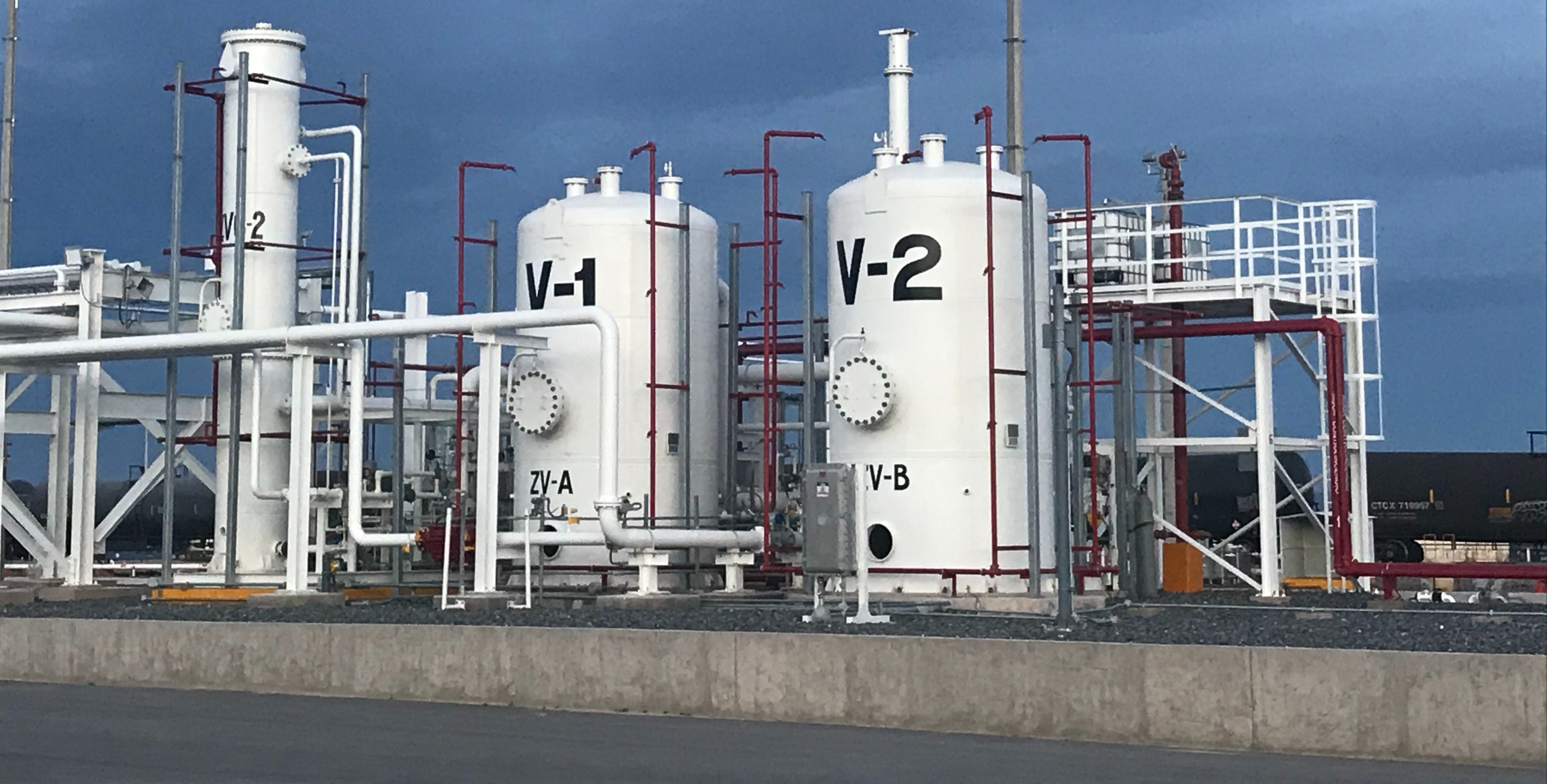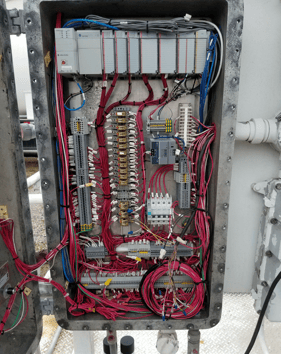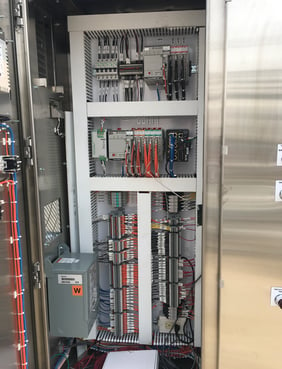The Increasing Importance of Upgrading PLCs in VRU Applications
CATEGORIES:

What is the actual cost of downtime when a vapour recovery unit (VRU) or vapour combustor unit (VCU) has a catastrophic failure? Today, that cost can be unacceptably high. Most pumps can be repaired or carbon replaced within a few days, but losing the brain of your system – the programmable logic controller (PLC) – could impact operations for far longer. The US is experiencing significant and, sometimes, unprecedented issues with PLC components. PLC equipment is rapidly becoming outdated and, in some cases, no longer supported. With that in mind, it is critical to consider steps to prevent a major failure that could cost days or possibly weeks of equipment downtime.
A brief history of PLCs
The first industry to deploy PLCs into its operations was the automotive sector. Before PLCs, most equipment controls were based on relays and timer logic. Control cabinet space was at a premium, sequencing adjustments were limited and manual, and any system function changes would typically require major design updates.
With the introduction of PLCs, hardware space became less of a requirement, and major or minor system operation changes could both be implemented quickly. As quickly as PLC technology could be developed, it was deployed; PLCs became the industry standard for machinery control. Almost all electromechanical equipment is now powered by a PLC of some kind.
Like most industries, the original petrochemical emission control equipment used in refineries and terminals was relay logic controlled. In the mid-1980s, VCUs were beginning to be integrated with PLC-type logic controllers. In the 1990s, equipment manufacturers began to standardise on General Electric (GE) and Allen Bradley (AB) types of PLC controllers due to their compact space requirements and simplicity of operation.
The first PLCs used in vapour control equipment were two GE models, followed by AB model PLCs in the late 1980s and early 1990s. Equipment manufacturers quickly began integrating PLCs into most vapour control equipment. As is the case with most technology, the controllers continued to improve rapidly, and by the early to mid-2000s, these initial versions were already being discontinued.
The discontinuation of these products created serious operational concerns because maintaining the uptime of emission control equipment depends heavily on the PLCs that run it holding up and being supported in the future.
The current state of PLCs
Today’s vapour control equipment has new emission control equipment systems with even more sophisticated electronic controls technology. Feedback from devices such as continuous emission monitors (CEMS) is constantly recorded for documentation and maintenance purposes. Additionally, system processes are continuously reviewed and adjusted automatically by the controls system to allow the equipment to adapt to different changes in the operation. Operators rely on the data collected by PLCs more than ever.
Due to the recent disruption in logistics, manufacturing operations and production, industry is seeing tremendous delays in new and replacement PLC component deliveries and much slower support of this newer style controls technology.
Discontinued units and their associated hardware, like the PLC models manufactured before the early 1990s, are becoming more difficult to locate. Most suppliers are no longer electing to carry the older models because they know those controllers are discontinued. Because of this, the possibility of experiencing significant downtime or failures due to a PLC problem has increased dramatically.
Zeeco recommends that all customers take inventory of the current PLC that controls their equipment. Operators should seek the support of their internal maintenance teams or other vapour service providers, such as Zeeco, to document the PLC component part numbers, locate critical spares for their system, and ensure they have a backup copy of the PLC programme that operates each system. Many parts, even those that are discontinued, are sometimes still available on the internet, but sourcing in this way can be unreliable. These internet-sourced parts may be used, unpackaged, or old inventory with risks. Because there are so many different varieties of CPUs, input modules, and output modules, having an inventory available at very short notice can be next to impossible for most vendors. The loss of a single PLC component could be the difference between one hour vs multiple days of downtime.
What is the next step?
If minimising downtime is a critical focus, one should consider upgrading PLC systems to newer and more reliably-supported technology and having spare PLC modules on hand. At a minimum, the spare parts required to manage downtime situations from a reliable vendor should be secured.
Manufacturers can provide support for a system’s PLC programme or, in many cases, can send a technician onsite to back up a PLC programme for future needs. Regardless of the manufacturer, a qualified controls expert can help determine the best solution. Replacing an existing unit with newer technology is also an option.
Zeeco recommends a turnkey experience for this type of important undertaking. Preventing downtime is a primary objective, so locating a provider who can help design and pre-build the replacement PLC is the best course of action. Protecting the site from the risk of equipment that is no longer supported is important, as is modifying terminals to enhance and improve their system’s operation and performance.
If the PLC equipment project is replacement-in-kind, upgrades can be completed with as little as one day of downtime when planned appropriately. If the site is considering upgrades that may dramatically improve functionality, reduce power consumption, or enhance data collection, additional days of downtime may be required. For more significant controls upgrades, the site may want to consider a backup system, such as a rental vapour control system, to maintain operations during these modifications. Zeeco can provide multiple rental equipment options to allow the site to maintain operations in compliance while repairs occur.
When considering a PLC upgrade, it is important to keep in mind that newer technology can do much more than just protect against downtime. Upgrading to a newer PLC can also make the system smarter. In this new era of environmental, social, and governance (ESG) mandates, a newer PLC can support smarter operations that reduce power consumption and equipment run time. Data collection for predictive maintenance, emissions monitoring, power conservation, and operator interaction are all benefits of new PLCs. They can even provide early warning data to prevent critical failures, as well as operator instructions and parts identification data. Older liquid-ring VRUs (glycol systems) can be easily retrofitted to dry vacuum pump technology. Continuous emission monitoring can easily log and protect data. Newer controls also allow for further equipment modifications that will increase the system’s overall capability to shrink each facility’s emissions and energy footprint.
How to know if an upgrade is required
If a site’s vapour control unit PLC was developed and installed before the early 1990s, the site should consider taking steps to identify and locate supporting hardware, or consider a full replacement to newer, better-supported technology.
Key considerations:
- Since these units were first installed, there have been continual software improvements, resulting in multiple versions being created every year. Many automation support teams may not carry the specific software version of the site’s PLC, so knowing what this is and understanding whether the site’s chosen maintenance provider supports it is critical. If they do not support it, the site is at risk of lengthy downtime.
- Much like cellular phone connectors, older PLC connectors are sometimes difficult to locate. Over the years, changes and improvements were made to these connectors, so connecting to an older PLC can be limited by having the correct cables to access the programme.
- As older automation engineers retire, new personnel may not be familiar with the old technology. Long-term support for older equipment will be difficult.
- ESG considerations and regulatory authorities will evolve much more quickly in the coming years, so compliance is key as the focus on reducing harmful emissions of all types continues.
- New programming has user-defined datatypes (UDTs). These UDTs standardise blocks and data. UDTs facilitate standardisation across programming styles. Standardisation of programming optimises programming time and reduces the occurrence of programming issues.

Figure 1. Before: Older Model PLC Unit in a VRU Application

Figure 2. After: Upgraded to a modern PLC in a new panel, not in a classified area. Used previous control panel as a junction box.
Conclusion
There are three ways to replace a discontinued PLC with a new version.
There are new PLCs that have conversion options to upgrade the CPU but utilise existing or new I/O cards. The wiring swing arms will work with the new component, so a complete rewire of the panel is unnecessary. The new rack can be prebuilt and tested before being installed in an existing control panel.
Pre-building a new back panel with the new PLC hardware and terminations designed to fit an existing control panel results in a quick exchange. Disconnecting the power source and associated wiring allows the original control panel backplate to be removed, and the new pre-built (in some cases pre-wired) backplate with new PLC hardware can be dropped in and connected quickly. The new PLC can be pre-loaded with similar or upgraded programming to operate the unit.
If the existing control panel is limited on space, is in worn condition, or if the site wants to move the control panel into a different electrical classification area (e.g., Class 1 Div 1 area to a non-hazardous area), the site may want to consider a completely new control panel. Upgrading all of the ancillary components is the best way to prevent future failures. While it is a more painstaking approach than using a conversion kit, rewiring allows for a clean and complete break from old PLC hardware. This approach affords greater flexibility for the future and provides ease of access and room for the expansion that might be required for adding more technology and controls. This option has additional benefits because the site would replace old or brittle wiring on the skid. To avoid downtime during the changeover, a rental system can be deployed that will maintain operations within compliance.